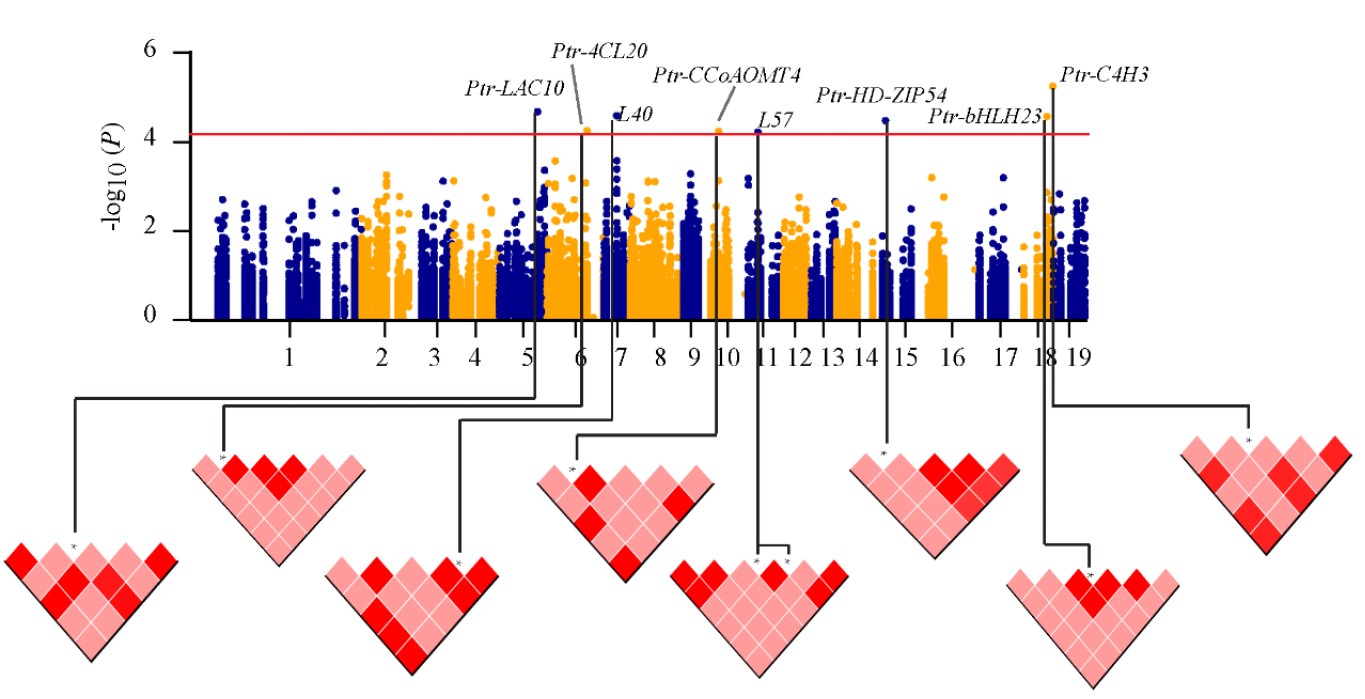博文
Plant Biotechnol J:杨树木质素生物合成的遗传调控通路
||
Genetic architecture underlying the lignin biosynthesis pathway involves non‐coding RNAs and transcription factors for growth and wood properties in Populus
First author: Mingyang Quan; Affiliations: Beijing Forestry University (北京林业大学): Beijing, China
Corresponding author: Deqiang Zhang (张德强)
Lignin provides structural support in perennial woody plants and is a complex phenolic polymer (酚类聚合物) derived from phenylpropanoid pathway (苯丙烷途径). Lignin biosynthesis is regulated by coordinated networks involving transcription factors (TFs), microRNAs (miRNAs), and long noncoding RNAs (lncRNAs). However, the genetic networks underlying the lignin biosynthesis pathway for tree growth and wood properties (材性) remains unknown. Here, we used association genetics (additive 加性, dominant 显性, and epistasis 上位性) and expression quantitative trait nucleotide (eQTN) mapping to decipher the genetic networks for tree growth and wood properties in 435 unrelated individuals of Populus tomentosa (毛白杨). We detected 124 significant associations (P ≤ 6.89E‐�5) for 10 growth and wood property traits using 30,265 single‐ ucleotide polymorphisms from 203 lignin biosynthetic genes, 81 TF genes, 36 miRNA genes, and 71 lncRNA loci, implying their common roles in wood formation. Epistasis analysis uncovered 745 significant pairwise interactions, which helped to construct proposed genetic networks of lignin biosynthesis pathway and found that these regulators might affect phenotypes by linking two lignin biosynthetic genes. eQTNs were used to interpret how causal genes contributed to phenotypes. Lastly, we investigated the possible functions of the genes encoding 4‐coumarate: CoA ligase (4-香豆酸辅酶A连接酶) and cinnamate‐4‐hydroxylase (肉桂酸-4-羟化酶) in wood traits using epistasis, eQTN mapping, and enzymatic activity assays. Our study provides new insights into the lignin biosynthesis pathway in poplar and enables the novel genetic factors as biomarkers for facilitating genetic improvement of trees.
木质素是源自于苯丙烷途径的酚类聚合物,为多年生的木本植物提供了结构支持。木质素生物合成受到转录因子、miRNA及长链非编码RNA(lncRNA)组成的复杂网络调控。然而,林木生长和木材材性相关的木质素生物合成通路潜在的遗传调控网络还不清楚。本文基于425个不相关的毛白杨个体,通过遗传学(加性、显性和上位性效应)和表达数量性状基因座(eQTN)作图研究了林木生长和木材材性相关的遗传调控网络。作者利用203个木质素合成基因、81个转录因子基因、36个miRNA基因以及71个lncRNA位点上共30,265个SNP鉴定了10个生长和材性性状相关的124个显著关联。上位性分析发现了745个显著的互作对,这对于构建木质素生物合成通路的遗传调控网络十分有帮助,并且这些调控子可能通过结合两个木质素生物合成基因来影响表型。作者进一步通过eQTN来阐述相关基因如何作用于植株表型。最后,作者通过上位性、eQTN作图及酶活性试验等方法研究了4-香豆酸辅酶A连接酶(4CL)和肉桂酸-4-羟化酶(C4H)可能的生物学功能。本文的研究揭示了杨树中的木质素生物合成通路的遗传调控网络,并且为促进林木遗传改良提供了新的遗传因子作为生物标记。
p.s. 加性效应:基因位点内等位基因的累加效应,是上下代遗传可以固定的分量,又称为"育种值”;
显性效应:基因位点内等位基因之间的互作效应,是可以遗传但不能固定的遗传因素,是产生杂种优势的主要部分;
上位性效应:是指不同基因位点的非等位基因之间相互作用所产生的效应;
eQTN:表达数量性状基因座,指的是能控制数量性状基因表达水平高低的那些基因的位点,eQTL把基因表达作为一种性状,研究遗传突变与基因表达的相关性。
通讯:张德强 (http://biology.bjfu.edu.cn/szdw/bqwrcgcgjjrx/269650.html)
�
�个人简介:1999-2002年,北京林业大学生物学院,博士;2002-2004年,中国林业科学研究院林业所,博士后。
研究方向:分子遗传学、功能基因组学和基因辅助育种。
doi: https://doi.org/10.1111/pbi.12978
Journal: Plant Biotechnology Journal
First Published: 27 June, 2018
(P.S. 原文下载:链接:https://pan.baidu.com/s/1qFiSsqwlF_7JjmGMbedfhQ 密码:dmu6)
�
https://blog.sciencenet.cn/blog-3158122-1122039.html
上一篇:New Phytologist:花器官演化与遗传调控(综述)
下一篇:Nature Plants:两个蕨类植物基因组揭示陆地植物演化
全部作者的其他最新博文
- • Plant Physiology:CsMADS3促进柑果中的叶绿素降解和类胡萝卜素合成(华中农业大学)
- • Molecular Plant:LBD11-ROS反馈调节作用于拟南芥的维管形成层增殖和次生生长(浦项科技大学)
- • Science Advances:根结线虫通过调控植物的CLE3-CLV1模块,促进侵染进程(日本熊本大学)
- • Nature Communications:油菜素内酯参与植物营养生长期转变的分子机制解析(浙江农林大学)
- • Current Biology:光合作用产生的蔗糖驱动侧根“生物钟”(德国弗莱堡大学)
- • PNAS:花同源异型基因在叶中被抑制、花中被激活的分子机制(南卡罗来纳大学)


